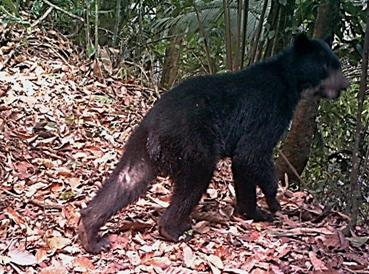Friday 18 November 2011.
The use of camera traps has allowed us to make records of species that are not easily observed, as in the case of large mammals such as the Andean bear (Tremarctos ornatus) VU. This is the only bear species found in South America and due to the degradation and destruction of their habitat, the Andean bear is listed as one of the carnivores most prone to extinction. Another problem facing the species is a lack of scientific data for local distribution and status within the Andes, making it difficult to monitor and asses changes in distribution and to establish realistic and effective actions for their conservation.
The Spectacled bear has a geographic distribution that extends along the tropical Andes and utilizes a wide variety of habitats between 250 and 4,750m above sea level. The El Paujil Bird Reserve is located within this altitudinal range in the Middle Magdalena Valley between the Departments of Boyacá and Santander, Colombia.
For two years we have used camera trap stations within the framework of Saving the Critically Endangered Blue-billed Curassow and Brown Spider Monkey Project to monitor the Blue Billed Curassow with support from the United States Fish and Wildlife Service. During surveys conducted during August 2011 the presence of an individual Tremarctos ornatus was recorded at 300m above sea level at 9:46 am, along one of the paths used for research in the reserve.

Spectacled bear (Tremarctos ornatus)
The existence of the El Paujil Natural Bird Reserve allows this species, whose population is estimated at less than 20,000 individuals in Colombia, to make use of more than 14,800 acres of healthy forest in the Serranía de las Quinchas and the Colombian Middle Magdalena. These images allow for recording charismatic species as the spectacled bear in time to make conservation decisions in this area, creating connectivity between habitats that hopefully ensure its survival as a species over time.
